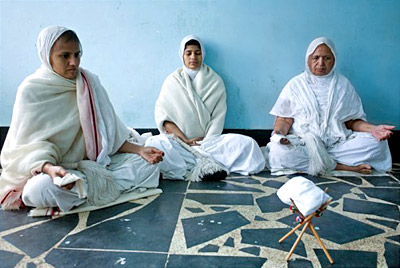A common man has to perform a number of rites from the morning to the evening. When he gets up from his bed in his last night watch, he chants the Paramesthi-Mantra and dedicates himself to pious thoughts. He has then in to fulfil "6 necessary duties" (Avasyaka). They are:
 1. Samayika, devotion lasting 48 minutes which is dedicated to the inner self-communion with a vow to keep oneself away from all evils.
1. Samayika, devotion lasting 48 minutes which is dedicated to the inner self-communion with a vow to keep oneself away from all evils.
2. Chaturvirhsatijinastuti, panegyric of 24 Tirthankaras.
3. Vandana, worship of Guru.
4. Pratikramana, confession.
5. Kayotsarga, remaining in a particular posture by which one should aim
at freeing the mind from the physical.
6. Pratyakhyana, taking a vow to renounce certain pleasures.
The Avasyakas are fulfilled either at home or in an Upasraya, and that too in the morning, noon and evening, and even more often. Visit to an Upasraya is connected with listening to a sermon.
Among Sthanakavasis, participation in public cult is restricted to a large extent. The followers of idol worship on the other hand participate in temple rituals at least once a day or even sometimes more than that.
As far as the meals are concerned it can be said that the Jains are satisfied with one meal a day. It is necessary to take the meal before nightfall and it has to be preceded by a prayer. The meals should also be accompanied by donations to ascetics or the needy.
When a Jaina goes to bed in the night, he utters again pious sayings and is engrossed in pious thoughts till he falls asleep which is beautified for him by lucky dreams as a reward for good works.
With reference to the daily rites of a common man among the Jainas it is said that three fires should be kindled in the morning, at the noon time and in the evening, according to Adipurana as, a memory of the cremation of Risabha`s mortal remains.
This article is a stub. You can enrich by adding more information to it. Send your Write Up to content@indianetzone.com




















